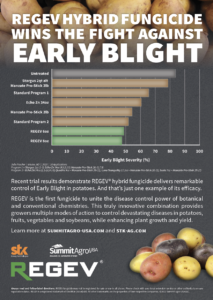Aug 12, 2021Trials of new ‘hybrid’ fungicide show effectiveness against early blight
The global search for plant-protection solutions that are both environmentally safe and effectiveness is driven by the need to supply food to the ever-growing world population.
The call for chemical load reduction is an important aspect for sustainable agriculture. Recently, documented issues of widespread environmental contamination, toxicity to non-target organisms and negative effects on human health by synthetic agrochemicals have led to a resurgence of interest in more natural means of pest and pathogen control, including intensified searches for new sources of biopesticides and botanical pesticides. The latest solutions are generally used in crop protection and contain secondary metabolites, which can be (but not always) involved in plant defense mechanisms. Among the latest solutions, the essential oils are considered to be attractive for plant protection.
Tea tree oil (TTO) is a valuable essential oil extracted by steam distillation of Melaleuca alternifolia (belonging to family Myrtaceae) leaves. It contains many components of terpenes, sesquiterpenes and their respective alcohol. The oil has been shown to be an effective antiseptic, antifungal and bactericide. In the past decade, it was found to be effective against a broad range of plant-pathogenic fungi in numerous crops, including vegetables, herbs, coffee, rice, grapevines, bananas and fruit trees.
New effective alternatives that can provide different and multiple modes of action with a lower risk for fungicide resistance, and which place a smaller chemical load on the environment concomitantly with consistent disease control, are required to increase options for the control of plant diseases.
The newly developed fungicide Regev EC (STK Bio-Ag Technologies, Petah Tikva, Israel) — a hybrid formulation containing 200 g/L of the systemic triazole fungicide difenoconazole plus 400 g/L of TTO — is a unique prepacked formulation which provides various mechanisms of action against broad-spectrum of plant pathogens and improved efficacy. The suggested hybrid solution can be the bridge between conventional agrochemical farming and sustainable farming. That’s because it is a pre-mix, so it is easy-to-use, in the exact same way as the grower’s current chemical pesticide.
Modes of action
The fungicidal and antimicrobial activities of TTO against fungal pathogens, as documented in the literature, are derived from its ability to inhibit respiration and disrupt the permeability barrier presented by the membrane structures of living organisms. Recents studies showed that TTO had a moderate effect against spore germination and significantly inhibited lesion development and sporulation of fungal pathogen. TTO was found to disrupt the fungal cell membrane and cell wall in plant tissue infected with pathogenic fungi, which explains why it exhibited strong curative activity against fungal pathogens, making it a unique product and enabling growers to use it even when the disease is already visible on the tissue. In addition, TTO was found to be an activator of plant itself defense mechanisms and systemically induced resistance in plants.
The sterol biosynthesis inhibitors, including difenoconazole, affect the fungal cell membrane by inhibiting C-14 demethylation of lanosterol or 24-methylenedihydrolanosterol, a biosynthesis step that occurs during conversion of lanosterol to ergosterol, the final product of fungal cell membrane sterol synthesis.
The different modes of action of TTO and difenoconazole, i.e. a combination of a natural product with broad-spectrum activity (TTO) and a traditional site-specific chemical, makes Regev an effective and unique tool for resistance management which is suitable for Integrated Pest Management (IPM) programs. This combination results in a reduced synthetic chemical load on the environment compared to other mixtures based on two traditional chemicals.
Field trials

Regev is currently used for controlling a broad range of diseases on arable crops, cereals, fruits crops and vegetables. Diseases effectively controlled by Regev include powdery mildews, apple scab (Venturia inaequalis), Black Sigatoka (Mycosphaerella fijiensis) in banana, species of Alternaria, Cercospora, Botrytis, Rhizoctonia, Pyricularia, Helminthosporium, Sclerotium and more. Numerous trials have been conducted with various crops in different countries.
(Regev also has been tested against early blight in potatoes. See graphic to the right. It’s trialed in use against alternaria alternata, aka brown leaf spot, a closely related pathogen to early blight. See graph below.)
In a field trials in Colombia, efficacy of Regev applied alone was compared to systemic fungicides, each applied in tank mixture with a protectant fungicide mancozeb. Untreated banana plants served as controls. Four foliar sprays of each fungicide/mixture were applied at spray volume of 19 L /ha at 10 days intervals.
Resistance management
Regev has a unique multiple functional activity and presents a lower probability for resistance development or cross-resistance in plant pathogens, so it could be an important tool in preventing development of cross-resistance during the season. Its application can be rotated with products that exhibit differing modes of action and to which populations of fungal pathogens have shown a loss of sensitivity, so that population of pathogens less sensitive to chemical products can be reduced.
Registration
Regev is already registered in Israel, Philippines, Serbia, United States and various Latin American countries for various crops and diseases. It is currently in the process of registration in Brazil, Mexico and the EU.
— Moshe Reuveni, chief scientist, STK bio-ag technologies, Israel








